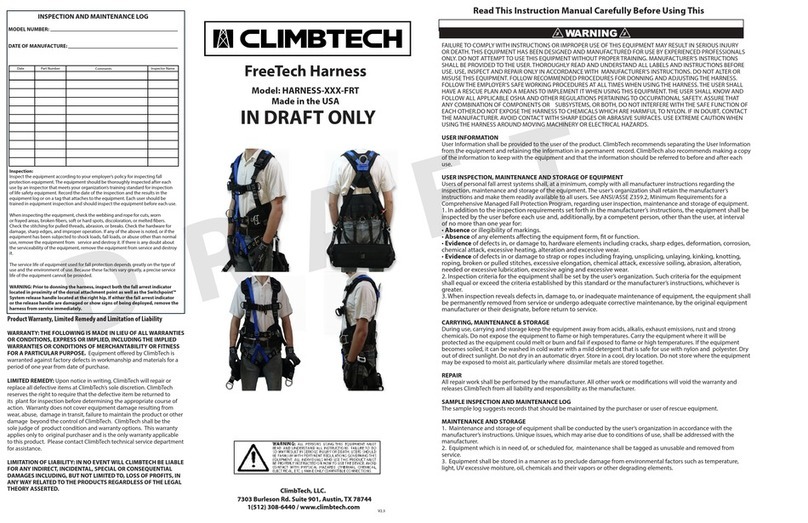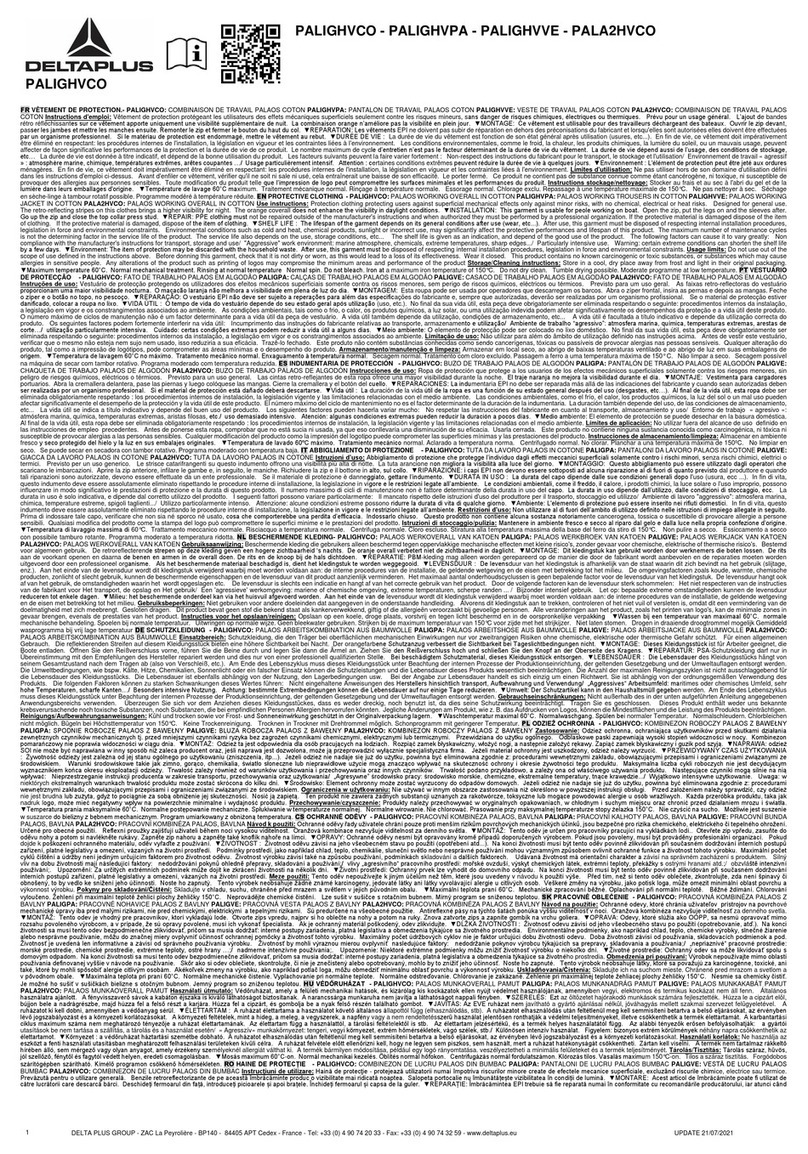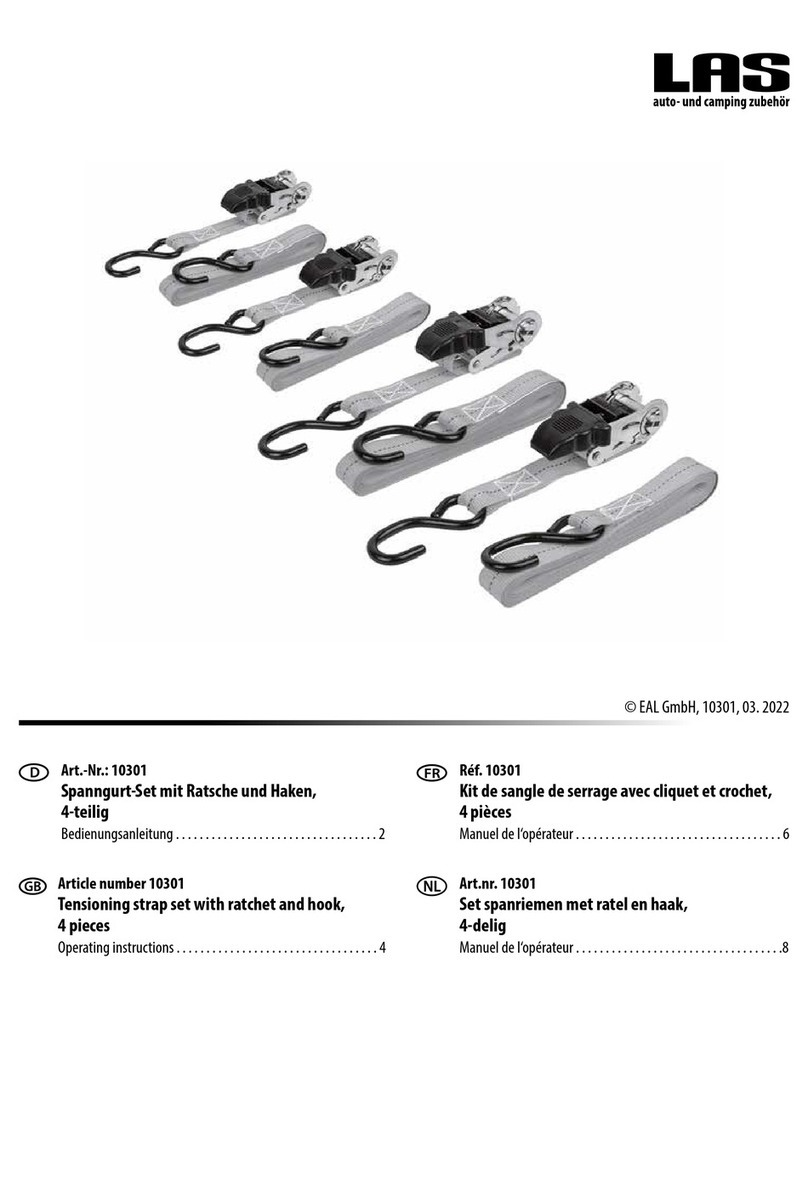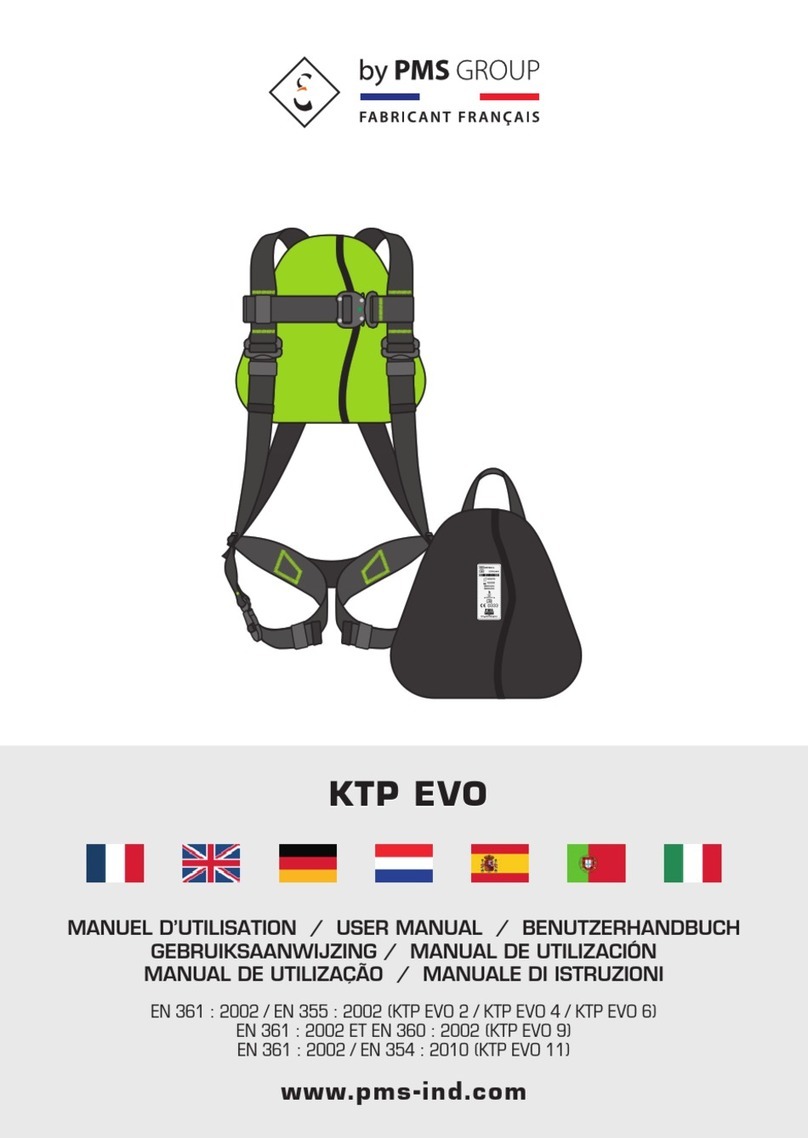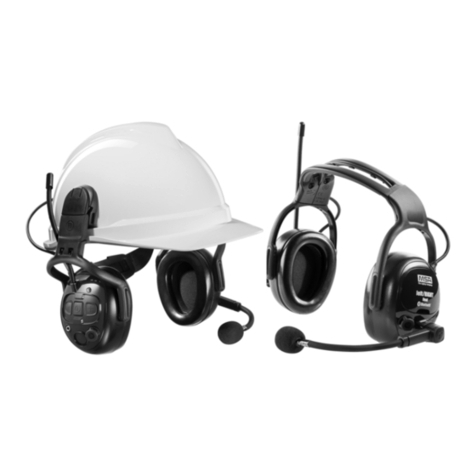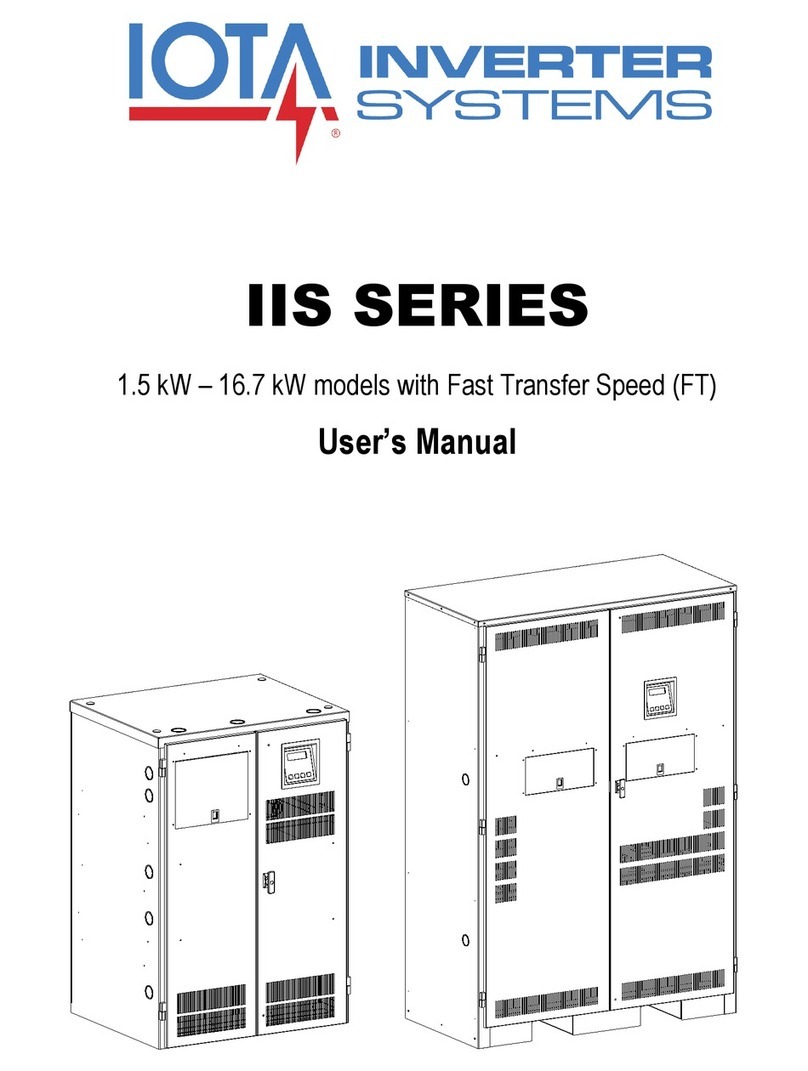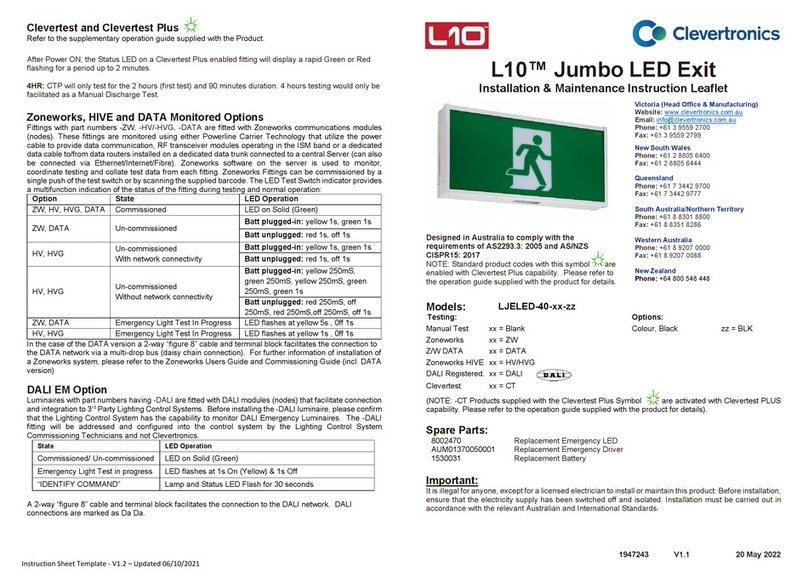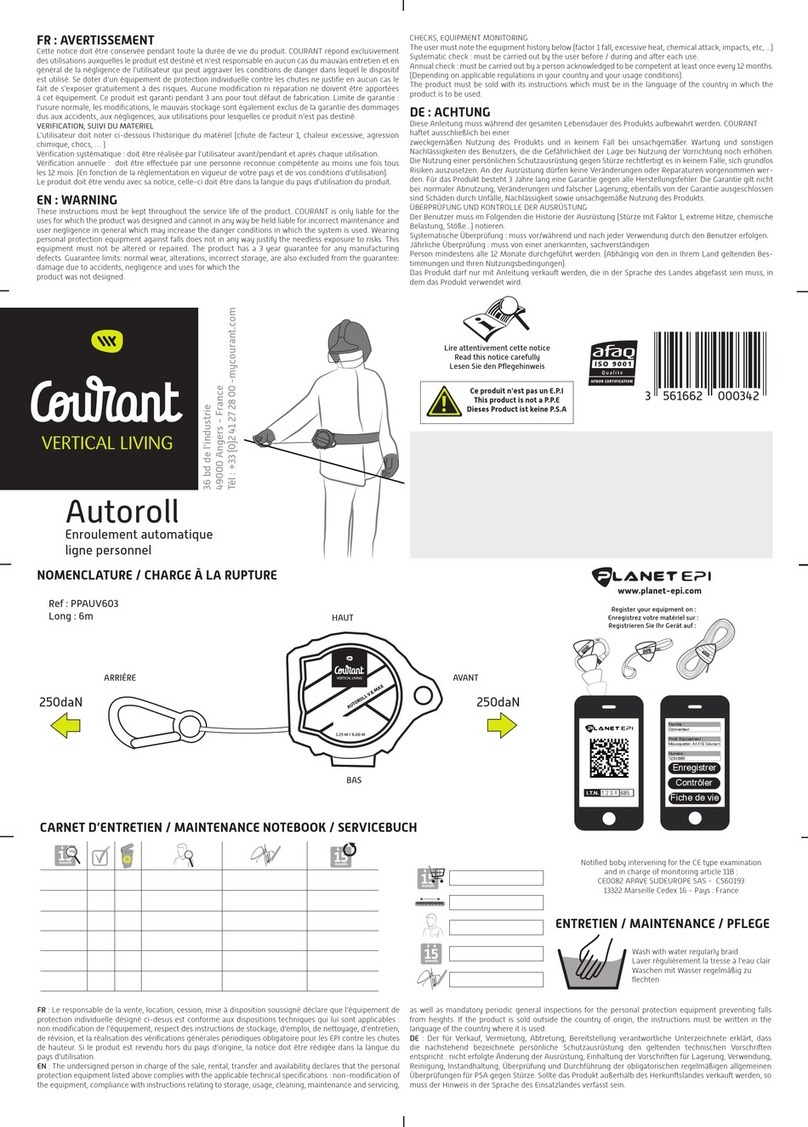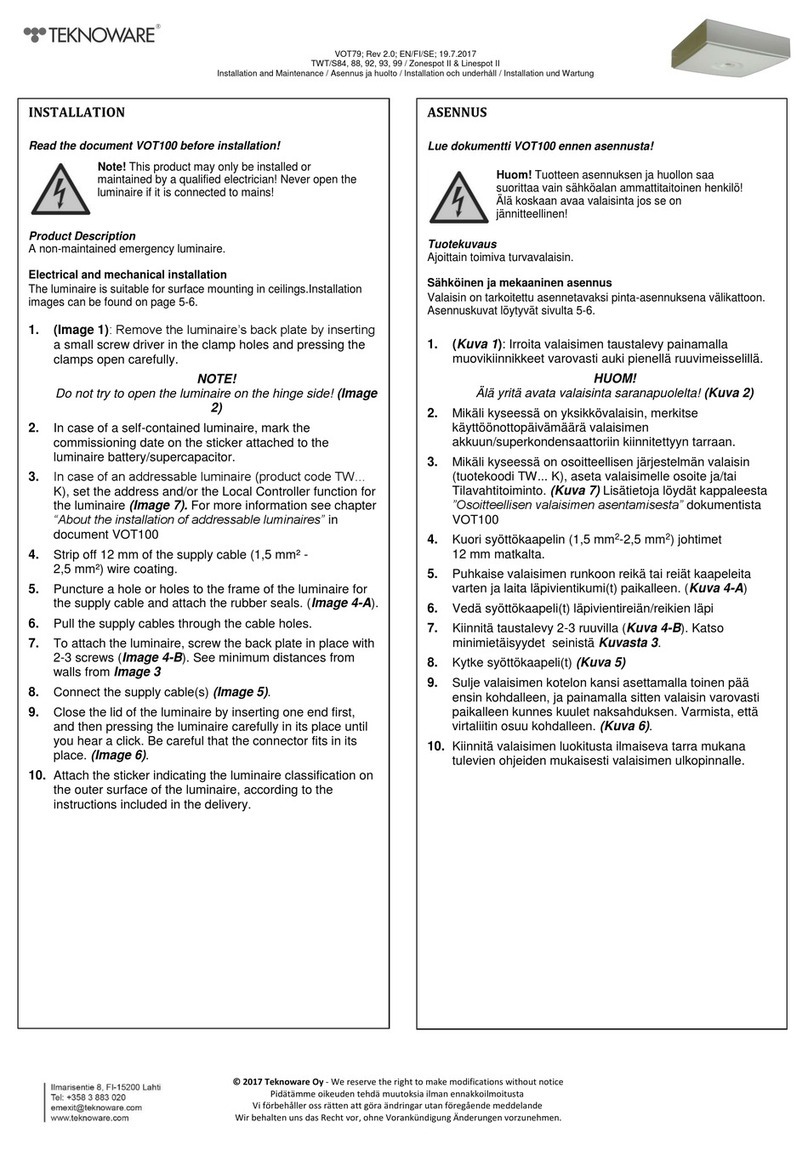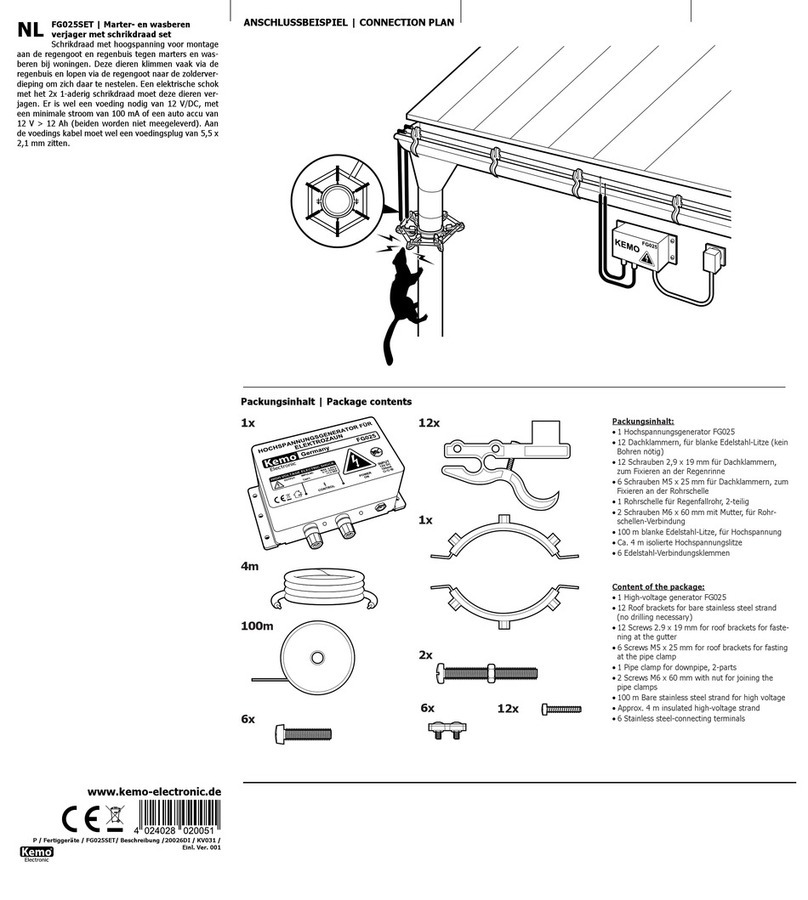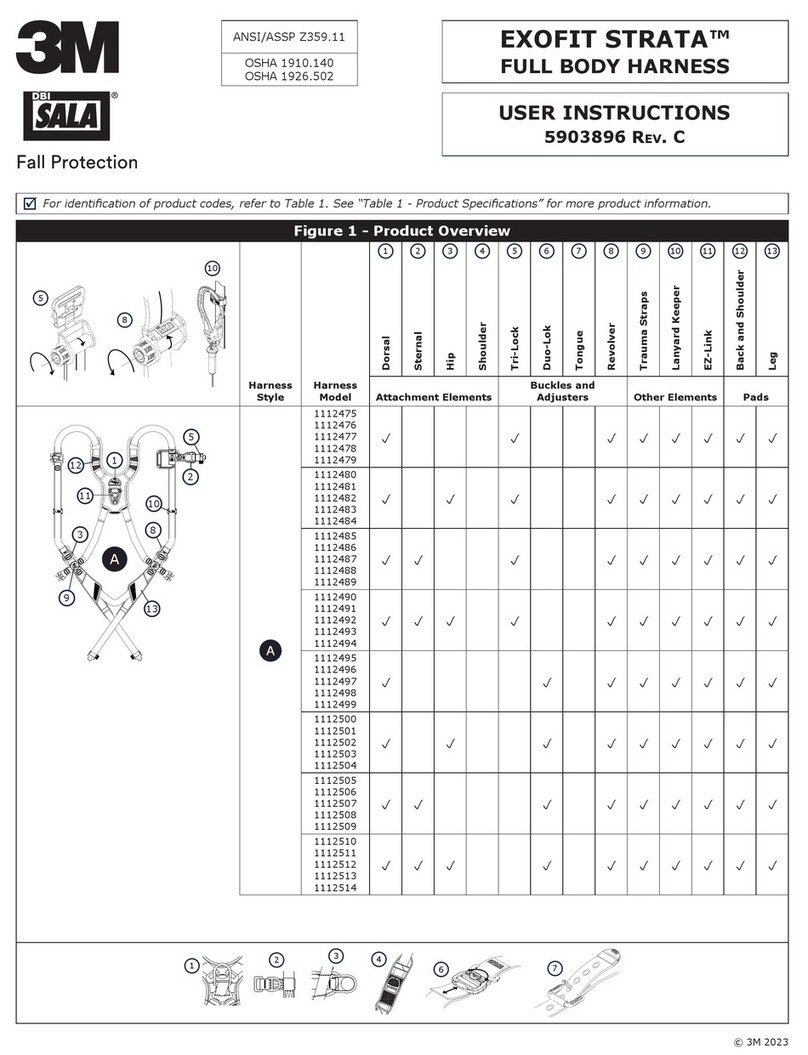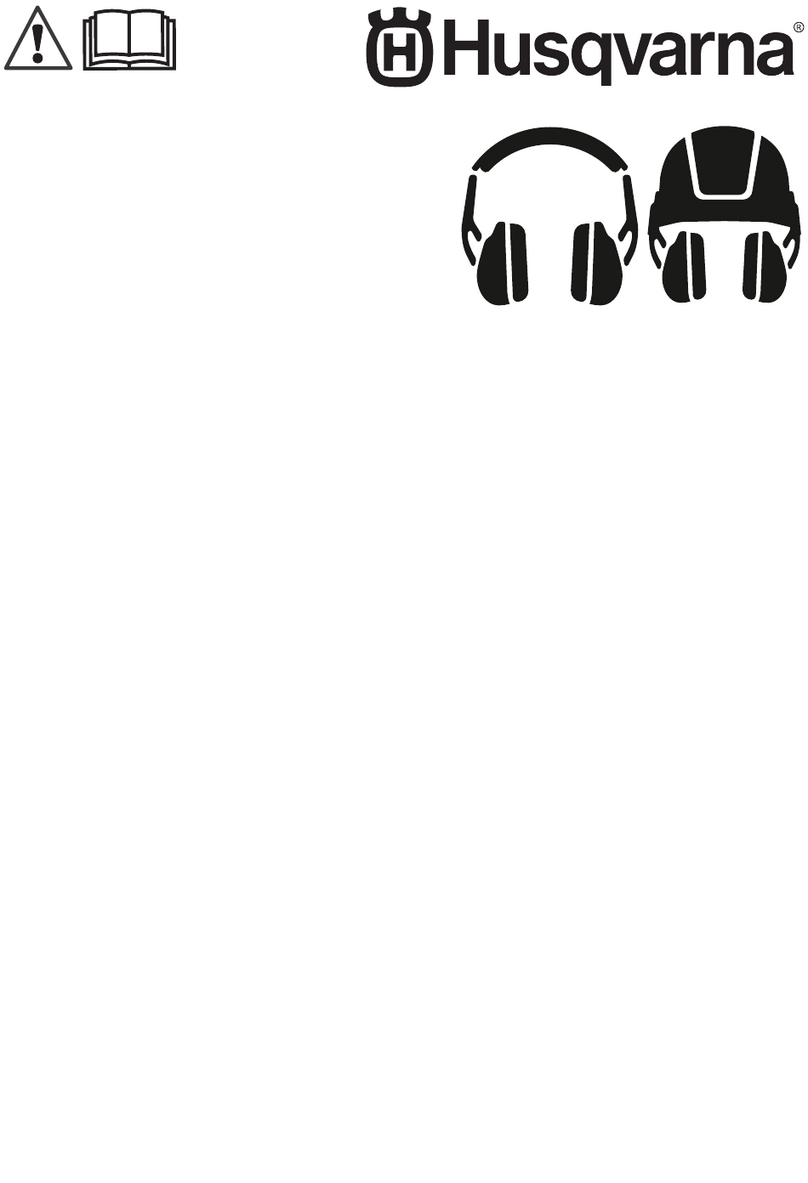Rheem 940001 Technical Document

Owner’s Guide
and
Installation Instructions
Rheem Guardian UV Disinfection
This UV system must be installed and serviced by a qualified person.
Please leave this guide with a responsible officer.

Page 2 of 22
CONTENTS
CONTENTS...................................................................................................................................................2
APPLICATIONS............................................................................................................................................3
GENERAL SAFETY INSTRUCTIONS..........................................................................................................4
REACTORS...................................................................................................................................................8
INSTALLATION CHECKLIST.......................................................................................................................9
ASSEMBLY...................................................................................................................................................9
OPERATION................................................................................................................................................15
MAINTENANCE ..........................................................................................................................................16
SERVICE PROCEDURES...........................................................................................................................17
SPARE PARTS ...........................................................................................................................................20
RHEEM UV DISINFECTION WARRANTY - AUSTRALIA ONLY..............................................................21

Page 3 of 22
APPLICATIONS
This UV system is designed for the purpose of disinfecting potable water. Its use in an application
other than this may shorten its life or reduce its effectiveness.
Disinfection by means of ultraviolet light (UV) is an effective and natural process of inactivating harmful
pathogens in water and air. UV light destroys pathogenic micro-organisms optimally by emitting UV-C
radiation at a wavelength of 254 nanometres (nm). The UV-C radiation inactivates micro-organisms
within a few seconds of exposure by disabling the DNA (deoxyribonucleic acid), resulting in their
inability to reproduce and subsequently causing cell death. UV light disinfection achieves this
naturally without leaving residual by-products or affecting the smell and taste of the water, therefore
reducing operator’s exposure to harsh chemicals or the need for extra processing to eliminate
chemical odour, taste or by-products.
The disinfection efficiency of a UV system is determined by; 1) the flow rate of water entering the UV
reactor chamber; 2) the UV Transmission (UV-T) which is the amount of light which penetrates the
water (determined by water quality) and; 3) the UV dose required to reduce water contaminants.
The sizing of a UV system should be based on these three parameters. Rheem UV disinfection
system is sized to match the maximum nominated flow rate of the relevant Guardian Warm Water
based on a 25mJ/m2UV dose in good quality clear water found in most metropolitan water supplies. A
free water test can be conducted if in doubt as to the UV transmission. Please contact Rheem for
further assistance.
Rheem UV lamps are low pressure, high efficiency lamps contained within a protective quartz thimble
which sit inside a high grade electro-polished reactor chamber allowing maximum water exposure to
UV light within the chamber for optimal pathogen destruction.

Page 4 of 22
GENERAL SAFETY INSTRUCTIONS
Symbol
Meaning
Symbol
Meaning
WARNING: ELECTRIC VOLTAGE!
ENSURE EYE PROTECTION IS WORN
ENSURE SAFETY GLOVES ARE
WORN
CAUTION UV-C RADIATION IS
HARMFUL TO THE EYES AND SKIN
THE NON-OBSERVANCE OF THESE INSTRUCTIONS CAN CAUSE SERIOUS INJURY AND
DANGER TO LIFE AND LIMB
WARNING:
UV lamps should be used only in the reactor chamber when sealing nut(s) have been fitted. Personnel
should never be directly exposed to UV-C light radiation.
Ensure this UV disinfection unit is only used for the intended purpose as described in the
operating instructions. The use of additional apparatus, which have not been recommended by
and are not sold by Rheem, may create an unsafe situation.
Do not use a unit with a damaged electrical lead or plug, or a unit with faulty functions or a unit
which has been dropped or damaged in any way.
Make sure that the unit is unplugged when it is not being used prior to fitting, or if removing any
parts. Do not remove the plug from the socket by pulling the electrical lead; instead take the plug
directly out of the socket.
Ensure that the unit is depressurised prior to maintenance work being carried out.
Do not use, connect or switch on the UV lamp outside the UV disinfection reactor chamber.
Ensure the UV disinfection unit is electrically isolated before:
1. Carrying out repairs. Rheem recommends that the maintenance be carried out only by
qualified personnel.
2. Cleaning and maintenance.
3. Replacement of the UV lamp.
The UV lamps have been designed for permanent operation to reach their highest disinfection
capacity. Frequent switching on and off reduces the life of the lamp.
This UV system should NOT be used without flowing water for long periods of time (max. 24
hours) or with hot water above 60oC. In case of either of these conditions the system is to be put
out of operation.

Page 5 of 22
The Rheem warranty may not cover faults if safety devices are tampered with or if the installation is
not in accordance with these instructions.
PRECAUTIONS
Where damage to property can occur in the event of the water heater leaking, the UV disinfection
system must be installed over safe tray. Construction, installation and draining of a safe tray must
comply with AS/NZS 3500.4 and all local codes and regulatory authority requirements.
The UV system must be maintained in accordance with the owner’s guide and installation instructions.
Refer to Maintenance on page 18.
If this UV system is to be used where an uninterrupted warm water supply is necessary for your
application or business you should ensure that you have back up redundancy within the warm water
system design. This should ensure the continuity of the warm water system in the event that this UV
system were to become inoperable for any reason. We recommend you seek advice from your
plumber or specifier about your needs and building back up redundancy into your warm water system.
HOW DO I KNOW IF THE UV SYSTEM IS INSTALLED CORRECTLY?
Installation requirements are shown on pages 10 to 16. The UV system must be installed:
by a qualified person, and
in accordance with the installation instructions, and
in compliance with Standards AS/NZS 3500.4, AS/NZS 3000 and all local codes and regulatory
authority requirements.
In New Zealand the installation must also conform with the New Zealand Building Code.
VICTORIAN CUSTOMERS
Notice to Victorian Customers from the Victorian Plumbing Industry Commission. This water heater
must be installed by a licensed person as required by the Victorian Building Act 1993.
Only a licensed person will give you a Compliance Certificate, showing that the work complies with all
the relevant Standards. Only a licensed person will have insurance protecting their workmanship for
6 years. Make sure you use a licensed person to install this water heater and ask for your Compliance
Certificate.
DOES WATER CHEMISTRY AFFECT THE UV DISINFECTION SYSTEM?
The UV system is suitable for most public water supplies, however some chemistries may have
detrimental effects on the UV system, its components and fittings.
If you are in a known harsh water area or you are not sure, have your water quality checked against
the conditions described on page 29.

Page 6 of 22
HOW LONG WILL THE UV DISINFECTION SYSTEM LAST?
The UV system is supported by a manufacturer’s warranty (refer to page 21).There are a number of
factors that will affect the length of service the UV system will provide. These include but are not
limited to the water chemistry, the water quality, the water pressure, the water temperature (inlet and
outlet), the water usage pattern and the quality of maintenance. Refer to “Precautions” on page 5.
Note: Critical components within the system require periodic replacement.
WATER SUPPLIES
This UV system must be installed in accordance with this advice to be covered by the Rheem
warranty.
This UV system is manufactured to suit the water conditions of most public reticulated water supplies.
However, there are some known water chemistries which can have detrimental effects on the UV
system and its operation and / or life expectancy. If you are unsure of your water chemistry, you may
be able to obtain information from your local water supply authority. This UV system should only be
connected to a water supply which complies with these guidelines for the Rheem warranty to apply.
Note: Some water analysis reports may state the conductivity of the water rather than the level of total
dissolved solids. Conductivity, measured in microsiemens per centimetre (µS / cm), is directly
proportional to the TDS content of the water. TDS, in mg / L, is approximately 70% of the conductivity
in µS / cm.
CHLORIDE AND PH
In a high chloride water supply, the water can corrode stainless steel parts and cause them to fail.
Where the chloride level exceeds 250 mg/L the Rheem warranty does not apply to the stainless steel
UV chamber in the UV disinfection system.
pH is a measure of whether the water is alkaline or acid. In an acidic water supply, the water can
attack stainless steel parts and cause them to fail.
Where the pH is less than 6.0 the Rheem warranty does not apply to the stainless steel UV chamber
in the ultra violet disinfection system.
Water with a pH less than 6.0 may be treated to raise the pH. The water supply from a rainwater tank
in a metropolitan area is likely to be corrosive due to the dissolution of atmospheric contaminants. This
may result in pH of less than 6.0. It is recommended an analysis on the water from a rainwater tank be
conducted prior to connecting this type of water supply to a system employing a stainless steel ultra
violet disinfection system.

Page 7 of 22
CHANGE OF WATER SUPPLY
The changing or alternating from one water supply to another can have a detrimental effect on the
operation and / or life expectation of the UV system.
Where there is a changeover from one water supply to another, e.g. a rainwater tank supply, bore
water supply, desalinated water supply, public reticulated water supply or water brought in from
another supply, then water chemistry information should be sought from the supplier or it should be
tested to ensure the water supply meets the requirements given in these guidelines for warranty to
apply.
SUMMARY OF WATER CHEMISTRY ADVICE AFFECTING WARRANTY
Water Chemistry
Component
Chloride > 250 mg/L
Stainless steel UV chamber
pH < 6.0
Stainless steel UV chamber

Page 8 of 22
REACTORS
This manual refers to the following UV disinfections systems.
Table 1a
Model No
Series
Length
No. Reactors in unit
Diameter mm
940001
4000-D-28 (LCE 4)
895mm
2
62
940002
15000-S-170 (LCS 17)
1210mm
1
76
Table 1b
Model No
Series
Inlet/outlet Ø
Min. space to service
reactor (mm)
Max. flow rate
L/min
940001
LCE 4 - 4000-D-28
2” BSP Nipples
1000
83*
940002
LCS 17 - 15000-S-170
2” BSP Nipples
1300
250*
*Maximum flow rate is at UV dose 25mJ/cm2. If in doubt a water sample must be taken and tested. Refer to
Applications on page 3.
INSTALLATION STANDARDS
The UV system must be installed:
by a qualified person, and
in accordance the installation instructions, and
in compliance with Standards AS/NZS 3500.4, AS/NZS 3000 and all local codes and regulatory
authority requirements.
In New Zealand the installation must also conform with the New Zealand Building Code.
All packaging materials must be removed from the warm water and UV unit prior to their installation.
WARM WATER UNIT APPLICATION
This UV system is designed for the purpose of disinfecting potable water. Its use in an application
other than this may shorten its life or reduce its effectiveness.
If this UV system is to be used where an uninterrupted warm water supply is necessary for your
application or business you should ensure that you have back up redundancy within the warm water
system design. This should ensure the continuity of the warm water system in the event that this UV
system were to become inoperable for any reason. We recommend you seek advice from your
plumber or specifier about your needs and building back up redundancy into your warm water system.

Page 9 of 22
INSTALLATION CHECKLIST
The following items must be checked prior to installation
A maximum operating pressure of 1000kPa (10bar) must not be exceeded.
A maximum ambient temperature of 45°C. (To be installed under a shelter)
The maximum water temperature should not exceed 55°C (De-energise UV system during any
heat disinfection process where the temperature exceeds 55°C).
ASSEMBLY
The following is a basic guideline for assembly of these units.
ASSEMBLY OF THE REACTOR CHAMBER
Prior to installation ensure the following:
The correct reactor chamber and coinciding power supply is being used.
There is enough working area around the reactor to service the glassware, (for dimensions see
table 1b),on page 8 otherwise maintenance of the unit will not be possible.
Picture 1 - Example of Standard UV reactor and power supply, size and shape may vary.
Reactor Chamber

Page 10 of 22
INSTALLING THE REACTOR
The reactor chamber (Picture 1) is to be fixed by means of the mounting brackets, either on the
wall or on a mounting frame.
Both disinfection chamber types can be mounted vertically or horizontally; the water should flow
in from the bottom and out through the top to prevent airlocks.
Refer to table 1b on page 8 for the distance required from the sealing nut, in order to enable
servicing of the unit.
When mounting the chamber, consideration must be made for the weight of the system due to
the stresses associated with pipework.
PLUMBING
Connect supply from the Guardian Warm Water outlet to UV chamber inlet using a
disconnection union and isolation valve
Connect outlet of UV chamber to warm water flow line using disconnection union and isolation
valve.
WARM WATER BY-PASS
To facilitate continuing warm water supply whilst servicing the UV unit, a warm water by-pass
should be installed prior to the isolating valve at the inlet and after the isolating valve at the outlet
of the UV unit. It is recommended to remove the handle from the by-pass isolating valve and
place it in the warm water cabinet during normal operation.
INSTALLING THE POWER SUPPLY
Power supply to the UV equipment shall be in accordance with AS3000 (230 Volt +10% - 6)
.The UV system is suitable for both indoor and outdoor installation under a shelter.
The power supply box must be mounted clear of the floor as a precaution against the ingress of
water.
It is good practice to not mount the power supply unit directly under the UV reactor or water flow
pipework to avoid leakage of water onto the power supply.
The cable provided with the power supply is 1.5meters which is the maximum recommended
distance the reactor chamber should be mounted from the power supply.
Fit to wall using holes provided.

Page 11 of 22
INSTALLING THE QUARTZ THIMBLE AND UV LAMP
Quartz thimble and UV Lamp are Fragile - Care must be taken when handling and installing
quartz thimble and UV lamp. When disassembling, hold both sealing nut and quartz thimble
to avoid the quartz thimble slipping out of the head piece!
Breakage due to mishandling is not covered by the Rheem warranty.
1. Unscrew the sealing nut from the top of the reactor; ensure that the “O” ring is also removed.
2. Lubricate the “O” Ring with silicon grease or petroleum jelly and place it inside the sealing nut so
that it is seated in its groove on the threaded side of the nut (Picture 3).
3. Wipe the quartz thimble down with a clean soft cloth soaked in methylated spirits, then dry it.
4. Keep a firm hold of the quartz thimble until it is located in its support.
5. Insert the quartz thimble, closed end first, into the reactor chamber until it is centred in its
support at the far end of the chamber.
6. Ensure the quartz thimble is centred correctly with no more that 14mm of quartz exposed above
the thread of the chamber (Picture 5). It is important the quartz thimble is correctly located in its
support; otherwise the quartz will be damaged when the sealing nut is tightened.
Picture 2
Picture 3
Quartz Thimble
O ring inside sealing nut

Page 12 of 22
7. During this next step the “O” ring should slip over the open end of the quartz thimble. Check this
by looking through the sealing nut to ensure the “O” ring does not become pinched, as this will
damage the quartz.
8. Screw the sealing nut with the “O” ring in place in a clockwise direction on to the reactor
chamber over the top of the open end of the quartz thimble that is protruding from the chamber.
IMPORTANT NOTE:
Care should be taken during the next step due to the fragile nature of the quartz thimble. Also
note that the sealing nut should only be tightened manually, any greater pressure could have a
detrimental effect on the quartz (do not tighten with multi grips).
9. Insert your finger through the top of the sealing nut and ensure the quartz thimble is sitting in the
groove of the nut.
10. Carefully tighten the sealing nut in a clock-wise direction until the “O” ring is just starting to be
compressed.
Picture 4
Picture 5

Page 13 of 22
Note:
When you reach this stage, the nut only needs to be turned ½ to ¾ of a turn to compress
the “O” ring sufficiently and form a seal. You may check the “O” ring has been
compressed well onto the quartz thimble by looking down through the sealing nut. Ideally
a good compression will see 2-3mm of “O” ring flattened around the quartz thimble.
At this stage it would be advisable to check the “O” ring seal against maximum water pressure
before installing the UV lamp.
During this next step care should be taken to not leave any markings on the UV lamp.
Do not touch the lamp without protective gloves.
If the chamber is installed vertically, NEVER drop the lamp into the quartz thimble, as this may
crack or break the thimble.
11. Remove the UV lamp from its protective wrapping and wipe down with a soft cloth soaked in
methylated spirits. Push the female 4 pin connector firmly onto the lamp pins.
(picture 7 & 8).
12. Using a soft cloth to hold the UV lamp, insert into the quartz thimble through the hole in the
centre of the sealing nut.
13. Always keep a firm hold of the UV lamp until it is secured into its four pin connector. Push the
female 4 pin connector firmly onto the lamp pins. (picture 7 & 8).
Picture 6

Page 14 of 22
14. Locate the three holes in the lamp connector end plate with the three holes on the end of the
sealing nut; screw all three 3mm screws through the holes in the end cap, into the sealing nut
(Picture 9).
BUILDING MANAGEMENT SYSTEMS (BMS)
The Rheem UV disinfection power supply can output up to a 240V/2A voltage free signal to a BMS to
indicate lamp run and/or fail status.
Connecting between common (C) & Normal Open (NO) indicates RUN status.
Connecting between common (C) & Normal Closed (NC) indicates FAIL status
Connect a cable to the terminals marked VFC/NO, NC,C as required. Connect the wires to the BMS
system, using an appropriate cable gland, following the BMS manufacturer’s recommendations.
Picture 7
Picture 8
end plate
Picture 9

Page 15 of 22
OPERATION
Once the UV reactor and power supply have been correctly installed and tested for leakage, operation
is as follows;
1. Ensure any valve is open to allow water flow through the UV disinfection unit.
2. Insert the power lead into the mains power source and switch on the power. The UV lamp will
ignite and come on, however it will take between 2 and 5 minutes for the lamp to reach full
output.
3. The unit will now be operational.
4. Stop/starting the UV lamp more than 4 times per day will reduce the lamp life time and
efficiency.
5. It is recommended lamps be replaced after 9000hrs of operation (approximately 1 year).

Page 16 of 22
MAINTENANCE
IMPORTANT
It is a requirement in NSW and may be a requirement in other states that the owner of a Warm Water
system is to register the installation with the local council or regulatory authority.
GENERAL
The maintenance of this product must be carried out in accordance with instructions given in this
Owners Guide, and must be conducted by designated, qualified and competent personnel.
A table is provided in the Guardian Warm Water Owner’s guide and installation instruction in the
Maintenance Log Sections on pg 24 and 25, which can be copied and used as a template for
recording purposes.
Rheem Service provides a comprehensive maintenance program structured to meet the most
stringent requirements to maintain the product at peak performance and monitor for the
presence of Legionella. Contact your nearest Rheem Service Department or Accredited Service
Agent to arrange a Service Contract inspection.
Storage of all UV disinfection equipment should be in a clean and dry place
UV MAINTENANCE SCHEDULE
Legionella Sampling –Unless prescribed by a regulating authority sampling at the following rates is
recommended:
First 3 months - 2 samples, once per month.
Month 6 –2 samples
6 monthly there after –2 samples
The above rates are applicable as long as legionella results are below prescribed limits
6 Monthly Check
- Check operation of UV, clean quartz tube if necessary
Annually
- As above and replace O-rings in UV
- Replace UV lamp

Page 17 of 22
SERVICE PROCEDURES
1. Switch off main power supply to the UV disinfection reactor.
2. Isolate water supply to the UV reactor chamber. Release pressure and drain water within the UV
reactor chamber.
3. Remove the three screws that mount the cap to the sealing nut (Picture 9) and slide the lamp out
enough to be able to remove the four pin plug (Picture 10).
4. Disconnect the four pin plug from the end of the UV lamp.
5. Remove the UV lamp from the reactor and store in a safe place.
At this stage the UV lamp can be replaced and the unit reassembled as per the above procedure OR
for cleaning or quartz thimble replacement continue as follows;
Quartz thimble and UV Lamp are Fragile - Care must be taken when handling and installing
quartz thimble and UV lamp. When disassembling, hold both sealing nut and quartz thimble
to avoid the quartz thimble slipping out of the head piece!
Breakage due to mishandling is not currently covered by the Rheem warranty.
During this step take care to hold onto the quartz thimble, as it may come out when you
remove the sealing nut.
6. Unscrew the sealing nut in an anti-clockwise direction.
7. Carefully remove the sealing nut from the quartz thimble.
8. Remove the quartz thimble from the reactor chamber.
Picture 10

Page 18 of 22
9. If the quartz thimble is due for replacement carefully unwrap the new quartz from the packaging.
10. If the quartz is due for a clean, wipe it down with methylated spirits or washed down with water.
It may be necessary to scrape off the remnants of the old “O” ring with a sharp knife. Repeat this
step until the quartz is clean.
11. Ensure that you wear protective gloves and wipe down the quartz thimble with a soft cloth that
has been soaked in methylated spirits, and then dry it.
12. Keep a firm hold of the thimble until it is located in its support. Ensure the thimble is centred
correctly with no more that 14mm of thimble exposed above the thread of the chamber. It is
important the thimble is correctly located in its support; otherwise the thimble will be damaged
when the sealing nut is tightened.
13. Insert the quartz thimble closed end first into the reactor chamber until it is centred in its support
at the far end of the chamber.
14. Place a small amount of silicon grease or petroleum jelly on the sealing nipple of the reactor
then clean the internal thread of the sealing nut with a soft cloth. Ensure that there are no foreign
particles that will interfere with the sealing of the “O” ring. During this next step the “O” ring
should slip over the open end of the quartz thimble.
15. Screw the sealing nut with the “O” ring in place in a clockwise direction on to the reactor
chamber over the top of the open end of the quartz thimble that is protruding from the chamber.
Picture 11

Page 19 of 22
16. Reinstall the UV lamp (see installation section)
POWER SUPPLY UNITS
The servicing of the power supply box should only be carried out by qualified service technicians. The
power supply box has a 5amp fuse which may need replacing. If the fuse has blown then the cause
must be determined before proceeding.
1. Switch OFF the mains power to the UV system.
2. Open the power supply box and remove the fuse holder by pulling it from the fuse terminal block.
3. Replace the fuse (11-FTB00.7) in the fuse holder.
4. Replace fuse holder in terminal box.
Power supply boxes contain a spare set of volt free contacts (vfc) for remote annunciation of lamp
failure and an audible lamp fail alarm will sound in the event of a lamp failure to notify operator to
replace UV lamp.
Picture 12

Page 20 of 22
SPARE PARTS
Below is a spare parts list with corresponding part numbers:
Model
940001
940002
Item
4000-D-28
15000-S-170
UV Lamp (ozone free)
11-L-GXO860L
11-L-AVP-L-300-2
Quartz Thimble
11-QT-090028
11-QT-121028
Ballast
11-EL-BAL-EC36/40
11-EL-BAL-170-E
Starter
11-EL-START-KUEFS600
N/A
Power Supply
11-U15000S76SS-PS-E170M
11-U4000-D-28-PSM40P2AM
Relay
11-EL-RELAY-TLY2-24LT
O-Ring (for quartz thimble)
11-O-UV-G28-S
O-Ring (for view port)
11-O-UV-VPS-S
Quartz window for view port
11-UVIDISC-MON-QSMALL
Sealing Nut / Power Head
11-SN-MOD-AL-28
Fuse
11-FTB00.7
This manual suits for next models
1
Table of contents

